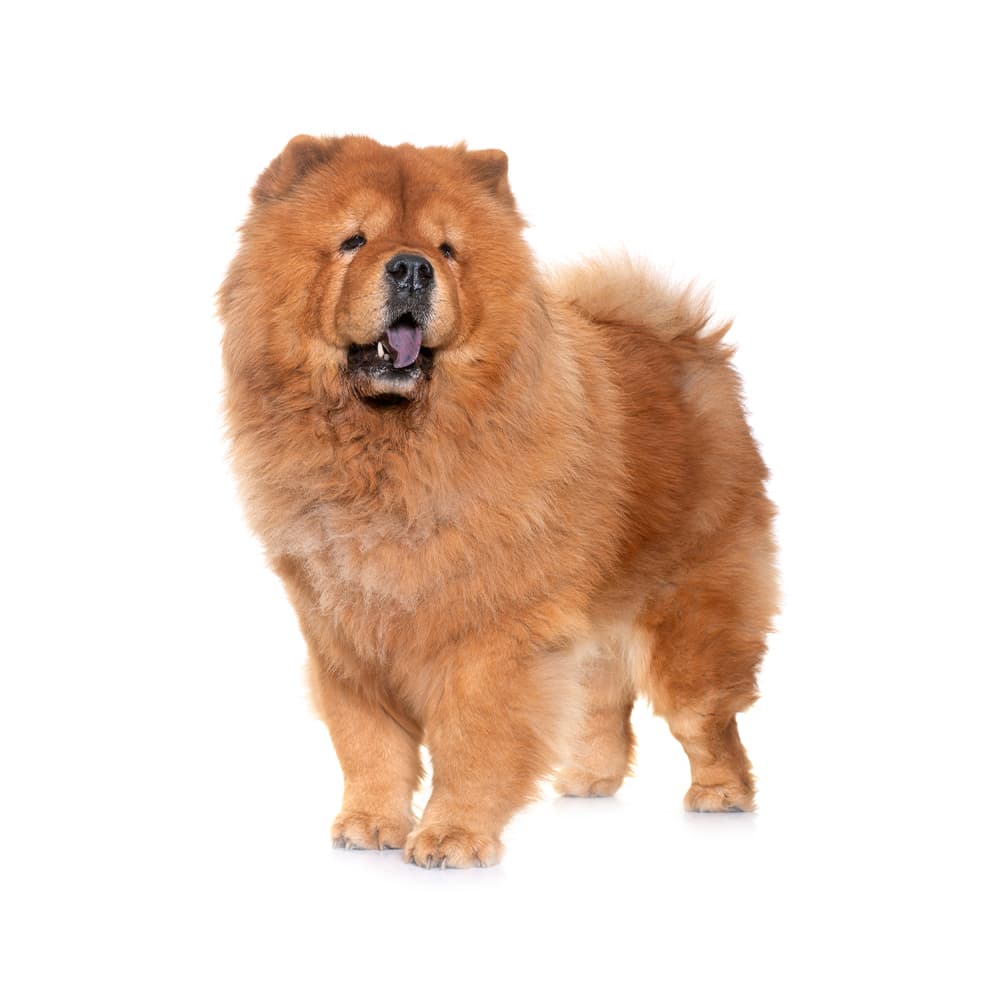Discover your dog's connection to this breed and 200+ others


Discover your dog's connection to this breed and 200+ others



The Chow Chow breed, also known as Songshi Quan (Pinyin: sōngshī quǎn 鬆獅犬), meaning puffy-lion dog, is one of the oldest dog breeds in the world, tracing its lineage back more than 2,000 years to ancient China. Originating in northern China, the breed was used for various purposes, including hunting, herding, and protection. The breed's plush coat served as insulation in cold climates, and their hunting skills made them invaluable to the ancient Chinese societies. The breed's name Chow Chow is believed to have originated from the British merchant ships in the 18th century that brought various items from the East to Europe, including these dogs.
Chow Chows may suffer from adrenal sex hormone imbalance, alopecia X, atopic dermatitis, atrioventricular heart block, cataracts, cerebellar hypoplasia, cervical vertebral instability, ciliary dyskinesia, color dilution alopecia, cor triatriatum, corneal dystrophy, cruciate ligament disease, deafness, dermatomyositis, dermoid sinus, diabetes mellitus, dysmyelinogenesis, ectropion, elbow dysplasia, elbow dysplasia (ununited anconeal process or fragmented coronoid process), elliptocytosis, entropion, exocrine pancreatic insufficiency, familial nephropathy, gastric carcinoma, gastric dilation/volvulus (bloat), glaucoma, growth hormone-responsive dermatosis, heart block, hip dysplasia, hypothyroidism, immunoglobulin A (IgA) deficiency, keratoconjunctivitis sicca, melanoma (oral), myotonia congenita, osteochondritis dissecans(elbow or stifle), osteogenesis imperfecta, pannus, panosteitis, patellar luxation, pemphigus foliaceus, persistent pupillary membranes, pituitary dwarfism, progressive retinal atrophy, pulmonic stenosis, renal dysplasia, sebaceous adenitis, tremor syndrome, tyrosinase deficiency, uveodermatologic syndrome, and ventricular septal defect. They may also suffer from allergies. Genetic testing is recommended, including for the following additional conditions: hyperuricosoria, degenerative myelopathy, and progressive rod-cone degeneration.
Chow Chows are often described as aloof and independent. They are reserved and discerning with strangers, making them excellent watchdogs. They are known for their dignified and regal demeanor, but they can be very loyal and affectionate with their family members. Chow Chows are not typically aggressive, but they can be protective and stubborn, making early socialization and obedience training important. This breed tends to be quiet and well-mannered indoors, making them suitable for apartment living. However, they do need regular exercise to keep fit and maintain a balanced temperament.
Despite their somewhat bear-like appearance and aloof demeanor, Chow Chows can be sensitive and appreciate a calm, stable environment. They are intelligent and can be trained, although they are sometimes seen as hardheaded because they prefer to do things their own way. The breed is generally good with children, but interactions with young kids should be supervised due to the Chow's size and strength.
A canine genetic lineage is a group of individuals or entire breeds that descended from common ancestors predating modern breed formation. Often these lineages are associated with a ‘type’ of dog with a unique historical working role and associated behaviors (e.g., herding, scent hunting, etc.).
Spitz and Sled Dogs originate in the Arctic and subarctic regions which caused them the develop adaptations to cold climates. Some of these adaptations give rise to characteristics of the lineage, most notably a dense double coat that helps with insulation. The lineage of these dogs can be followed back to ancient breeds developed by Indigenous people. These ancient breeds were used as an aid for transportation, herding, guarding, and hunting. These jobs have created dogs that are independent, intelligent and have strong work ethics as well as a sturdy body that helps them to pull sleds or go on long journeys over rough terrain.
Example breeds with ancestry from this lineage include Akita, Chow Chow, and Siberian Husky.
According to the AKC, Chow Chow owners praise the cleanliness of their dogs, saying that they have very little "doggy" odor, housebreak more easily than other breeds, and that they are "as fastidious as cats".
Chows are depicted in artifacts of China’s Han Dynasty (c. 206 b.c.), though experts say that there is evidence suggesting the history of the breed is much older.
The term "Chow Chow" was a catch-all term used to describe miscellaneous cargo on British merchant ships, and this name became associated with the breed itself.
Doi:10.1002/9781119540687
https://www.akc.org/dog-breeds/chow-chow/
https://www.petmd.com/dog/breeds/c_dg_chow_chow
https://embarkvet.com/resources/dog-breeds/chow-chow/
Recommended by top vets with decades of experience
21 breeds
64 genetic health markers
50 genetic trait markers
